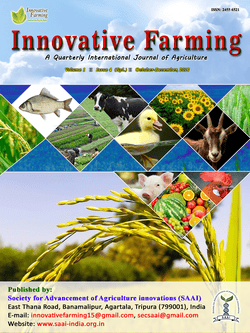
Horse Gram (Kulthi): Pulse of Rural Peoples in Chhattisgarh
Vikas Ramteke*
Indira Gandhi Krishi Vishwavidhyalya, Raipur, Chhattisgarh - 492012, India
Vivek Kumar Kurrey
Indira Gandhi Krishi Vishwavidhyalya, Raipur, Chhattisgarh - 492012, India
Thalesh Kumar Panigrahi
Indira Gandhi Krishi Vishwavidhyalya, Raipur, Chhattisgarh - 492012, India
Pooja Yadav
Indira Gandhi Krishi Vishwavidhyalya, Raipur, Chhattisgarh - 492012, India
DOI: NIL
Keywords: Horse gram, protein and medicinal
Abstract
Horse gram (Macrotyloma uniflorum Lam.) is a popular pulse, locally known as kulthi belongs to the family Fabaceae that still remain an under exploited legume crop. Horse gram (Macrotyloma uniflorum) is one of the inexpensive sources of protein, calcium and iron. Different parts of the plants are used for the treatment of heart disease, asthma, bronchitis, urinary discharges and for treatment of kidney stones. The present paper is article on its botany, medicinal uses and pharmacological properties.
Downloads
not found
Reference
Arora, R. K., & Chandel, K. P. S. (1972). Botanical source areas of wild herbage legumes in India. Trop. Grassland, 6, 213–221.
Bravo, L., Siddhuraju, P., & Saura-Calixto, F. (1999). Composition of underexploited Indian pulses. Comparison with common legumes. Food Chem., 64, 185–192.
Ghani, A. (2003). Medicinal Plants of Bangladesh with chemical constituents and use (2nd ed.). Asiatic Society of Bangladesh, Dhaka.
Peshin, A., & Singla, S. K. (1994). Anticalcifying properties of Dolichos biflorus (horse gram) seeds. Indian J. Exp. Biol., 32, 889–891.
Samanta, A. K., Kolte, A. P., Senani, S., Sridhar, M., & Jayapal, N. (2011). Prebiotics in ancient Indian diets. Current Sci., 101(1), 43–46.
Sreerama, Y. N., Sashikala, V. B., Pratape, V. M., & Singh, V. (2012). Nutrients and antinutrients in cowpea and horsegram flours in comparison to chickpea flour: Evaluation of their flour functionality. Food Chem., 131, 462–468.
Venkatesha, R. T. (1999). Studies on molecular aspects of seed storage proteins in horsegram (Dolichos biflorus L.) [Ph.D. thesis, Central Food Technological Research Institute, Mysore, India].
Yadahally, N. S., Vadakkoot, B. S., Vishwas, M. P., & Singh, V. (2012). Nutrients and antinutrients in cowpea and horse gram flours in comparison to chickpea flour: Evaluation of their flour functionality. Food Chem., 131, 462–468.
Zhang, J., Shi, X., Shi, J., Ilic, S., Xue, S. J., & Kakuda, Y. (2008). Biological properties and characterization of lectin from red kidney bean (Phaseolus vulgaris). Food Rev. Intern., 25(1), 1–34.
